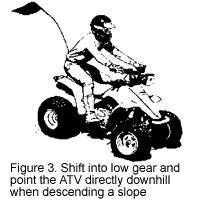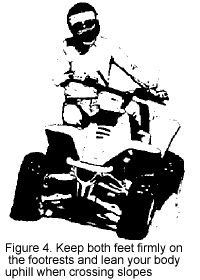Since their introduction, the use of all-terrain vehicles (ATVs) has increased dramatically each year. In addition to widespread recreational use, the agricultural sector has realized the value of the ATV as a workhorse. Unfortunately, fatalities and injuries involving ATVs are occurring at an alarming rate. The Consumer Product Safety Commission estimates that in 1990, the latest year for which statistics are available, 239 people died and 51,700 were injured in ATV-related accidents in the United States. Many of these needless accidents could have been prevented by knowing and following a few steps for safe ATV use.
PROTECTIVE GEAR
The following protective gear should be worn every time you ride an ATV:
PRE-RIDE INSPECTION
Check the following components before using your ATV:
OPERATING YOUR ATV
 Most ATVs have solid rear axles, which turn each of the rear wheels at the same speed. This requires special turning skills, which primarily involve shifting your body weight. Low-speed turns require that you shift your body weight forward and to the outside of the turn as you turn the handlebar. The objective is to reduce weight on the inside rear wheel. For turns at higher speeds, you must lean your upper body toward the inside of the turn while keeping your weight on the outer footrest. T is balances the higher cornering forces as vehicle speed increases. If your ATV starts tipping during a turn at any speed, lean your upper body farther into the turn while gradually reducing the throttle and making the turn wider (see Figure 1).
Most ATVs have solid rear axles, which turn each of the rear wheels at the same speed. This requires special turning skills, which primarily involve shifting your body weight. Low-speed turns require that you shift your body weight forward and to the outside of the turn as you turn the handlebar. The objective is to reduce weight on the inside rear wheel. For turns at higher speeds, you must lean your upper body toward the inside of the turn while keeping your weight on the outer footrest. T is balances the higher cornering forces as vehicle speed increases. If your ATV starts tipping during a turn at any speed, lean your upper body farther into the turn while gradually reducing the throttle and making the turn wider (see Figure 1).
Braking Begin the braking process by releasing the throttle and shifting to a lower gear well in advance of the intended stopping point. With this method, the engine helps to slow your ATV. Applying brakes smoothly and evenly will bring your ATV to its quickest stop. Apply brakes lightly on slippery surfaces. When descending a hill, shift to a lower gear for engine braking rather than riding the brakes for an extended period of time.
Climbing
 The first rule to remember is to stay off hills too steep for
your ability or that of your ATV. When approaching a hill, you
should keep both feet firmly on the footrests and shift your
body weight forward by sliding forward on the seat. For steep
hills, stand on the footrests and lean forward to shift as much
weight forward as possible. To reduce the chance of stalling
the engine, climb hills in a low gear. If the engine does stall,
you must apply the brakes before the forward motion stops. I
your ATV stalls and then rolls backward, apply brakes slowly.
Rapidly applying brakes during a backward roll can cause a rear
overturn (see Figure 2).
The first rule to remember is to stay off hills too steep for
your ability or that of your ATV. When approaching a hill, you
should keep both feet firmly on the footrests and shift your
body weight forward by sliding forward on the seat. For steep
hills, stand on the footrests and lean forward to shift as much
weight forward as possible. To reduce the chance of stalling
the engine, climb hills in a low gear. If the engine does stall,
you must apply the brakes before the forward motion stops. I
your ATV stalls and then rolls backward, apply brakes slowly.
Rapidly applying brakes during a backward roll can cause a rear
overturn (see Figure 2).
Descending Before descending a hill, you should shift the transmission into a low gear and point the ATV directly downhill. Keep both feet firmly on the footrests and slide back on the seat to increase your stability and the effectiveness of the brakes (see Figure 3).
Riding across slopes Avoid crossing steep slopes and slopes where there is slippery or bumpy terrain. If you do ride across slopes, keep both feet firmly on the footrests and lean your body uphill. If the ATV begins to tip, turn the front wheels downhill. If the terrain prohibits your turning downhill, dismount on the uphill side immediately (see Figure 4).
Additional equipment Many operators are taking advantage of the additional equipment available to increase the uses of their ATVs. This equipment can be divided into two categories: that which is rigidly mounted on the ATV and pull-type equipment that is towed by the ATV's drawbar. While this equipment can increase your machine's uses, it imposes some new operating restrictions that must be followed for safe operation.
 Rigid mount equipment is usually bolted to the front or rear
of the machine and includes luggage racks to transport feed
or supplies, broadcast seeders and wick applicators for chemical
weed control. This type of mounting places the entire weight
burden on your ATV. You should realize that this will have
a significant impact on the weight and balance of your machine.
The center of gravity may be moved to a position of lessened
stability. Mounting on the front can make steering more difficult
nd decrease traction on the rear wheels. Mounting on the rear
can increase the chance of a rear overturn. Either mounting
can increase the chance of a side overturn and requires added
caution when operating on level as well as sloped ground.
Rigid mount equipment is usually bolted to the front or rear
of the machine and includes luggage racks to transport feed
or supplies, broadcast seeders and wick applicators for chemical
weed control. This type of mounting places the entire weight
burden on your ATV. You should realize that this will have
a significant impact on the weight and balance of your machine.
The center of gravity may be moved to a position of lessened
stability. Mounting on the front can make steering more difficult
nd decrease traction on the rear wheels. Mounting on the rear
can increase the chance of a rear overturn. Either mounting
can increase the chance of a side overturn and requires added
caution when operating on level as well as sloped ground.
Pull-type equipment attached to the drawbar varies from a wagon of firewood to a row-crop sprayer. This type of mounting also has an effect on an ATV's stability. As the amount of drawbar pull required for the load increases, so does the tendency for the front end of the ATV to rise. Caution should be used not to expect more from your ATV than it can safely provide.
Whenever equipment is added, counterweights can be used to offset the load and improve the new balance of your machine. Be careful not to exceed the weight limitations set forth by the ATV manufacturer. Remember, just because your ATV can pull a heavy load does not mean it can safely stop it.
 Additional equipment may also require additional protective
gear for the operator. Examples of this include protection
from objects thrown by a mower and chemical protection from
the drift of sprayers.
Additional equipment may also require additional protective
gear for the operator. Examples of this include protection
from objects thrown by a mower and chemical protection from
the drift of sprayers.
For more information on equipment towing considerations and chemical protection devices, see MU publications MO008, Personal Protective Equipment for Working with Pesticides, and AS247, Safe Tractor Operation.
AGE AND LEGAL REQUIREMENTS
Operator age The Missouri Public Safety Department estimates that in an average year, 44 percent of the ATV accidental death toll involves children under 16 years of age; 20 percent of the fatalities are children under 12. Under the new state legislation, a person under 16 can legally operate an ATV but must be under adult supervision while on land owned by anyone other than the parent or guardian. Parents should remember that while not all children are the same, those under 12 are typically lack the physical size and strength, cognitive abilities and motor skills needed to safely operate any size of ATV.
Public highways Operation of ATVs is prohibited on Missouri highways. Exceptions to this rule include ATVs owned by a government entity, held for official use, or operated for agricultural purposes between sunrise and sunset. The governing body of each city and county also may issue special permits to licensed drivers for special use of ATVs on city streets or county roads. All operators of any ATV being used on a public roadway must have a valid driver's license.
Passengers No ATV shall carry a passenger except when being used for agricultural purposes.
Alcohol No person shall operate an ATV while under the influence of alcohol.
TRAINING COURSE
ASI offers a free training course to individuals who purchased a new ATV after December 31, 1986. The free training also is available to all members of the purchaser's immediate family who are in the recommended age group for the ATV purchased. The ATV RiderCourse is a one-day, hands-on safety training program. The training includes pre-ride inspections, starting and stopping, turning, operation on hills, emergency stopping and swerving, and riding over obstacles. It also covers protective riding gear, environmental concerns, local laws, and safety techniques. The training course is taught by certified instructors at hundreds of locations across the United States.
Publication #: G1936
This document is apart of a series from the Department of Agricultural Engineering, University of Missouri-Columbia. If you have special needs as addressed by the Americans with Disabilities Act and need this publication in an alternative format, write ADA Officer, Extension and Agricultural Information, 1-98 Agriculture Building, Columbia, MO 65211, or call (314) 882-8237. Reasonable efforts will be made to accommodate your special needs. Publication date: January 1994.
Funding for this publication was provided by the University of Missouri-Columbia/National Institute for Occupational Safety and Health Cooperative Agricultural Promotions Agreement U05/CCU706084-01.
Portions of this publication are reprinted with copyright permission of the Specialty Vehicle Institute of America.
David E. Baker and Rusty Lee. Department of Agricultural Engineering, University Extension, University of Missouri and Lincoln University, Columbia, MO 65211.
Disclaimer and Reproduction Information: Information in NASD does not represent NIOSH policy. Information included in NASD appears by permission of the author and/or copyright holder. More